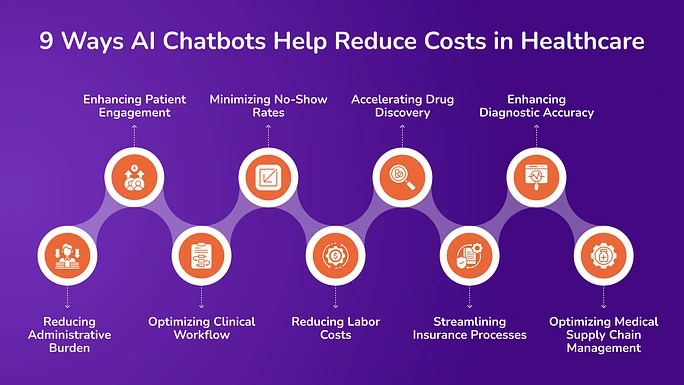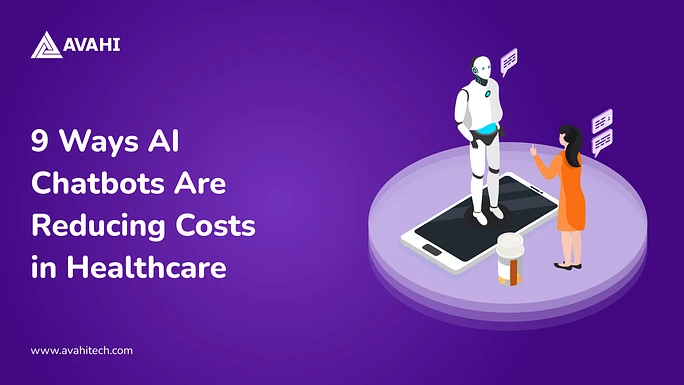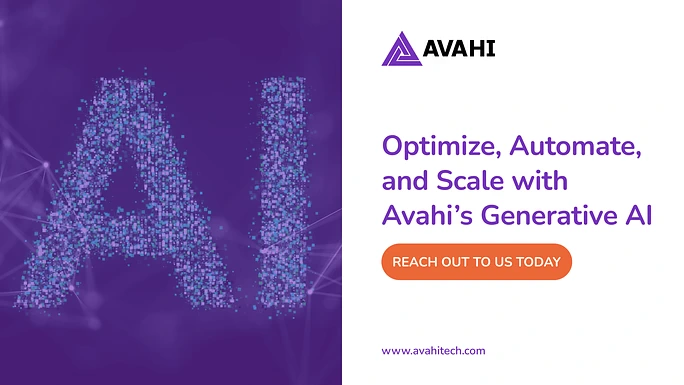The healthcare sector was filled with long wait times, overwhelming paperwork, and expensive treatments. Patients often faced long wait times, delayed treatments, and confusing insurance processes. Hospitals struggled with managing endless paperwork, scheduling appointments, processing claims, and answering patient inquiries—all of which required a significant workforce and added to operational expenses.
With the introduction of Artificial Intelligence (AI), AI chatbots now handle patient inquiries, book appointments, process insurance claims, and assist with symptom assessments without human intervention. Advanced AI diagnostic tools help doctors detect diseases faster and more accurately, reducing the chances of misdiagnosis and unnecessary treatments. Hospitals use AI to predict patient trends, manage medical supplies, and prevent waste, cutting costs at every level.
The impact is undeniable. 79% of healthcare organizations are presently utilizing AI technology. The global AI healthcare market is expected to grow from $22.4 billion in 2023 to over $100 billion by 2030. AI-driven automation could save the industry $360 billion annually by reducing paperwork, optimizing workflows, and improving efficiency.
AI isn’t here to replace doctors or nurses but to support them, making healthcare faster, more innovative, and more cost-effective. This blog will explore how AI chatbots transform healthcare by reducing costs and enhancing efficiency.
The Rising Costs in Healthcare and the Need for Innovation
Healthcare costs are rising unsustainable, putting financial pressure on hospitals, clinics, and patients. Below is the list of major cost drivers in healthcare:
1. Administrative Expenses
Much healthcare spending goes toward administrative tasks such as patient scheduling, billing, and insurance processing. Studies show that administrative costs can account for up to 25% of total healthcare expenditures. Hospitals and clinics need large teams to handle paperwork, manage records, and coordinate patient interactions, increasing labor costs.
2. Patient Engagement and Communication
Adequate patient support requires dedicated staff to answer queries, book appointments, and manage follow-ups. Call centers and front-desk operations require substantial investment in personnel and technology. Missed appointments and lack of patient adherence to treatment plans lead to inefficiencies and lost revenue.
3. Staffing Shortages and Burnout
The healthcare industry faces a growing shortage of medical professionals, increasing the burden on existing staff. High workload and administrative responsibilities contribute to burnout among doctors and nurses. Hiring and training new employees to handle routine tasks adds to operational costs.
4. Limitations of Cost-Cutting Measures
Many healthcare organizations try to reduce costs through various other methods. Still, these methods have limitations. Cutting jobs can lead to longer wait times, lower patient satisfaction, and increased workload for remaining employees.
While outsourcing can save money initially, it often leads to inefficiencies and quality issues. While avoiding new technologies may seem cost-effective in the short term, it can result in outdated systems and increased long-term expenses.
What Are AI Chatbots in Healthcare?
AI chatbots are virtual assistants designed to interact with patients and healthcare professionals using artificial intelligence (AI). These chatbots can use text, voice, or mobile apps to handle everyday healthcare tasks.
Their primary function is to assist with administrative tasks, provide medical information, and improve patient engagement. By automating routine processes, AI chatbots help reduce the workload for healthcare staff while enhancing patient support.
Types of AI Chatbots in Healthcare
1. Rule-Based Chatbots
These chatbots operate on predefined scripts and decision trees. They follow programmed rules to answer common questions like clinic hours, insurance details, or appointment availability. They work well for straightforward tasks but struggle with complex or unpredictable queries.
2. AI-Powered Chatbots (Machine Learning & NLP-Based)
These chatbots use machine learning (ML) and natural language processing (NLP) to understand and respond to human language. They can analyze patient input, learn from interactions, and provide more personalized and context-aware responses. AI-powered chatbots can handle more complex healthcare scenarios like symptom analysis and virtual health assessments.
Applications of AI Chatbots in Healthcare
1. Symptom Checking and Preliminary Diagnosis
AI chatbots can assess symptoms based on patient input and suggest possible conditions. They use medical databases to provide preliminary recommendations, such as whether a patient should seek immediate care or monitor symptoms at home. This helps reduce unnecessary clinic visits and supports patients in making informed health decisions.
2. Appointment Scheduling and Management
Patients can use chatbots to book, reschedule, or cancel appointments without calling a healthcare provider. Automated reminders help reduce no-show rates, ensuring better time management for patients and doctors. Chatbots can also check provider availability and suggest the earliest possible appointment slots.
3. Patient Triage and Directing to the Right Care
AI chatbots can ask patients about their symptoms and guide them to the appropriate level of care. They may recommend home remedies or schedule a telehealth consultation for non-urgent issues. They can direct patients to emergency services or connect them with a specialist for urgent cases.
4. Medication and Treatment Reminders
Chatbots can send automated reminders for medication schedules, follow-up appointments, and therapy sessions. They help improve patient adherence to treatment plans, reducing complications from missed doses.
5. Billing and Insurance Assistance
Patients can use chatbots to check insurance coverage, understand billing statements, and process payments. Chatbots can answer questions about co-pays, deductibles, and claim status without human intervention.
9 Ways AI Chatbots Help Reduce Costs in Healthcare

AI chatbots are transforming the healthcare industry by automating routine tasks, improving efficiency, and reducing operational costs. Here’s how they contribute to financial savings across different areas.
1. Reducing Administrative Burden
Administrative tasks account for a significant portion of healthcare costs. AI chatbots help automate these processes, reducing the need for human intervention and minimizing errors.
AI chatbots allow patients to reschedule or cancel appointments without speaking to a receptionist. They can also send automated reminders to reduce no-shows, ensuring better time management for doctors and patients.
Chatbots can help verify insurance coverage, check policy details, and process claims. Reducing paperwork and errors helps hospitals and clinics get reimbursements faster and avoid disputes with insurance providers.
AI chatbots can handle many patient inquiries—such as clinic hours, doctor availability, and essential medical guidance. This reduces the workload on administrative staff and call centers, allowing human representatives to focus on complex cases.
2. Enhancing Patient Engagement
Effective patient engagement is essential for improving health outcomes and controlling costs. AI chatbots improve patient experience by providing instant and accessible support.
Patients often have simple but repetitive questions regarding prescriptions, lab results, or aftercare instructions. Chatbots can instantly provide accurate responses, reducing the need for phone calls or in-person visits.
Unlike human support teams with limited working hours, AI chatbots operate around the clock. They provide immediate responses, reducing patient wait times and minimizing the need for large customer service teams.
Many patients forget to take prescribed medications or follow post-treatment care instructions. AI chatbots send automated reminders to help patients stick to their treatment plans, improving recovery rates and reducing the likelihood of hospital readmissions.
3. Optimizing Clinical Workflow
AI chatbots assist medical staff by automating routine interactions, allowing doctors and nurses to focus on critical patient care.
Chatbots can ask patients about their symptoms and guide them to the right specialist or department. This reduces unnecessary visits to general practitioners and ensures faster access to the correct treatment.
Chatbots can address many patient inquiries—such as medication side effects, lifestyle changes, or essential health advice—preventing healthcare staff from being overwhelmed with minor concerns.
Some AI chatbots integrate with electronic health records (EHRs) and clinical databases to assist doctors in diagnosing conditions and recommending treatment options. This leads to faster, more accurate decisions and better patient outcomes.
4. Minimizing No-Show Rates
Missed appointments and unnecessary emergency room visits contribute to rising healthcare costs. AI chatbots help address these issues by guiding patients more efficiently.
AI chatbots remind patients about upcoming visits, reducing no-show rates and improving healthcare providers’ scheduling efficiency.
Patients often visit the ER for minor issues that don’t require emergency care. AI chatbots can evaluate symptoms and recommend visiting an urgent care center, booking a telehealth consultation, or monitoring their condition at home.
AI chatbots help patients avoid expensive ER visits unless necessary by providing initial guidance and virtual consultations. This reduces congestion in emergency departments and lowers overall healthcare costs.
5. Reducing Labor Costs
Labor is one of the most significant expenses in healthcare, especially in administrative and support roles. AI chatbots help reduce the need for excessive staffing.
Since AI chatbots handle many routine tasks, healthcare organizations can operate with fewer support staff, saving costs. Doctors and nurses often spend valuable time on documentation and patient inquiries. AI chatbots free them from these tasks, allowing them to concentrate on providing quality care.
Automating repetitive administrative functions leads to long-term financial savings by improving efficiency and reducing human errors that result in costly corrections.
6. Streamlining Insurance Processes
Medical billing and insurance claims are complex processes leading to delays, disputes, and financial losses. AI chatbots help streamline these operations.
Chatbots provide instant explanations of medical bills, breaking down costs and payment options. Patients can also make payments directly through chatbot-assisted portals.
AI chatbots help patients understand their insurance coverage, submit claims, and track reimbursement status. By reducing errors in claim submissions, they speed up the approval process and improve healthcare providers’ cash flow.
Incorrect billing is a major issue that leads to disputes and financial losses. AI chatbots minimize human errors by cross-referencing patient records and insurance policies, ensuring accurate invoicing.
7. Accelerating Drug Discovery
Developing a new drug is expensive and time-consuming. It often costs billions of dollars and takes decades. Multiple clinical trials add further costs, and success is not guaranteed.
AI is helping pharmaceutical companies cut R&D expenses by identifying promising drug candidates faster using predictive algorithms and reducing the need for excessive laboratory testing by simulating drug interactions digitally.
Optimizing clinical trial design, ensuring the right patient groups are selected for testing.
By automating and improving accuracy in drug discovery, AI significantly shortens the time required to develop effective medications, ultimately lowering costs for pharmaceutical companies and patients.
8. Enhancing Diagnostic Accuracy
Misdiagnosis can lead to unnecessary treatments, prolonged hospital stays, and costly malpractice lawsuits. AI-driven diagnostic tools help reduce these risks by analyzing medical images and patient data more precisely than human specialists.
AI accurately detects abnormalities in medical scans (X-rays, MRIs, CT scans) and minimizes human error when diagnosing complex conditions. By reducing diagnostic errors, AI improves patient safety and cuts costs associated with incorrect treatments and legal claims.
9. Optimizing Medical Supply Chain Management
Poor inventory management in healthcare leads to wasted supplies, expired medications, and high operational costs. AI-powered tools help hospitals maintain an efficient supply chain by predicting the demand for medical supplies based on patient trends and identifying expiring medications early to prevent waste.
With AI-driven forecasting, hospitals can minimize emergency purchases, cut storage expenses, and ensure resource use efficiency.
Best Practices for AI Chatbots in Healthcare to Reduce Costs
Below are the best practices to ensure AI chatbots effectively reduce costs while improving patient care and operational efficiency.
1. Automate Routine Administrative Tasks
AI chatbots should handle repetitive administrative functions, freeing human staff for more critical tasks. Important areas for automation include appointment scheduling and answering frequently asked questions (FAQs) to reduce call center workload and improve response times.
Healthcare providers can cut labor costs and reduce administrative inefficiencies by automating these tasks.
2. Ensure 24/7 Patient Support
AI chatbots should be available around the clock to respond instantly to patient inquiries. This helps reduce unnecessary emergency room (ER) visits by guiding patients to appropriate care options and minimizing the need for additional medical consultations by offering symptom assessments and self-care advice. 24/7 support reduces patient dependence on costly in-person visits and call center operations.
3. Integrate Chatbots with Electronic Health Records (EHRs)
AI chatbots should integrate with EHR systems to provide accurate and personalized responses. This allows chatbots to access patient history, provide relevant guidance based on past diagnoses and treatments, and instantly assist healthcare providers by retrieving necessary patient information.
4. Use AI Chatbots for Symptom Assessment and Triage
AI chatbots should assist in symptom assessment to help patients determine the right level of care. Effective triage can prevent unnecessary hospital and clinic visits, reduce overcrowding and costs, and direct patients to telehealth services when in-person care isn’t needed.
5. Continuously Train and Update Chatbot Knowledge
AI chatbots must be regularly updated with the latest medical guidelines, insurance policies, and healthcare protocols. Best practices include machine learning and NLP improvements to enhance chatbot accuracy over time and keeping medical information current to ensure reliable guidance.
Regular updates ensure AI chatbots remain relevant, accurate, and effective in cost reduction.
6. Prioritize Data Security and Compliance
Since AI chatbots handle sensitive patient data, they must comply with healthcare regulations such as HIPAA (in the U.S.) and GDPR (in Europe). To maintain security, ensure end-to-end encryption to protect patient information. Use strict authentication and access controls to prevent data breaches. Communicate privacy policies to build patient trust. Strong data security measures avoid legal issues and maintain patient confidence in AI chatbots.
Optimize, Automate, and Scale with Avahi’s Generative AI
At Avahi, we empower businesses to deploy advanced Generative AI that streamlines operations, enhances decision-making, and accelerates innovation—all with zero complexity.
As your trusted AWS Cloud Consulting Partner, we empower organizations to harness AI’s full potential while ensuring security, scalability, and compliance with industry-leading cloud solutions.
Our AI Solutions Include
- AI Adoption & Integration – Leverage Amazon Bedrock and GenAI to enhance automation and decision-making.
- Custom AI Development – Build intelligent applications tailored to your business needs.
- AI Model Optimization – Seamlessly switch between AI models with automated cost, accuracy, and performance comparisons.
- AI Automation – Automate repetitive tasks and free up time for strategic growth.
- Advanced Security & AI Governance – Ensure compliance, fraud detection, and secure model deployment.
Want to unlock the power of AI with enterprise-grade security and efficiency?
Start Your AI Transformation with Avahi Today!




